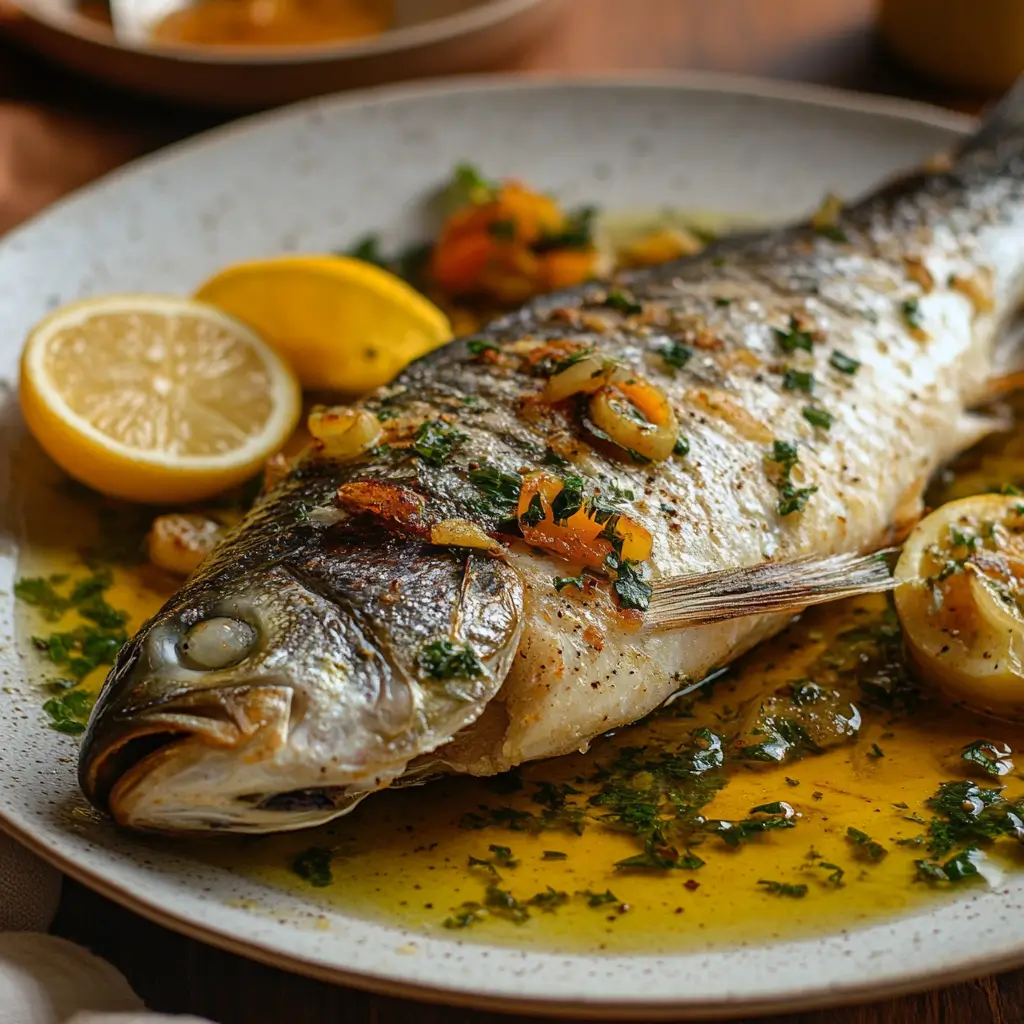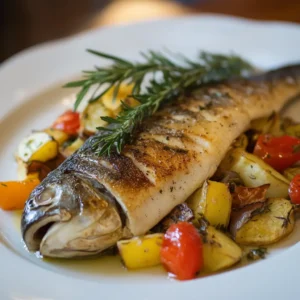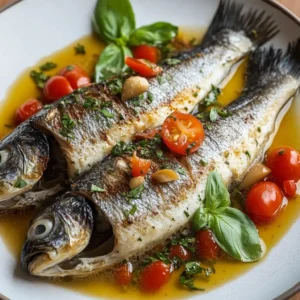Is branzino healthy? Absolutely! Branzino, also known as European sea bass, is packed with nutrients that can benefit your overall health. This mild, flaky fish is a rich source of lean protein and heart-healthy omega-3 fatty acids. These essential fats help reduce inflammation, support brain health, and promote cardiovascular wellness.
If you’re watching your calorie intake, branzino is a great choice. With fewer calories than many other fish, it fits well into weight-loss diets. Additionally, it contains important nutrients like vitamin D, selenium, and potassium, which help boost immune function and maintain strong bones.
So, is branzino healthy for everyday meals? Yes! It’s versatile, delicious, and easy to cook—whether you prefer it grilled, baked, or pan-seared. Add vegetables and a squeeze of lemon for a well-rounded, nutritious dish.
Introduction to Branzino
What is Branzino?
Branzino, scientifically known as Dicentrarchus labrax, is a saltwater fish native to the Mediterranean Sea and the eastern Atlantic Ocean. This silvery, streamlined fish is celebrated for its mild, slightly sweet taste and tender texture, making it a popular choice in many Mediterranean cuisines. Its versatility in cooking methods, from grilling to baking, further adds to its appeal as a flavorful and healthy seafood option.
Origins and Cultural Significance of Branzino
Branzino has deep roots in Mediterranean culture, especially in Italian, Greek, and Spanish cuisines. It’s often the star of traditional dishes, such as baked branzino with herbs or grilled branzino drizzled with olive oil and lemon. The fish’s delicate flavor and tender texture make it a favorite among coastal culinary traditions. Its availability and versatility in Mediterranean recipes have solidified branzino as a symbol of the region’s rich and vibrant food culture.
Nutritional Profile of Branzino
Macronutrients: Protein, Fat, and Carbs
Branzino is an excellent source of lean protein, with a single serving (about 3.5 ounces) providing approximately 20 grams of protein. It is low in carbohydrates and contains moderate amounts of healthy fats, primarily unsaturated fats. This makes branzino a nutritious choice for those looking to maintain a balanced diet, supporting muscle growth and overall health while keeping calorie intake in check.
Essential Micronutrients: Vitamins and Minerals
Rich in vitamins such as B12 and D, branzino also contains essential minerals like selenium, iodine, and potassium. These nutrients play a crucial role in supporting vital bodily functions, including metabolism, thyroid health, and immune system strength. The combination of these nutrients makes branzino a highly nutritious fish, contributing to overall well-being and a healthy lifestyle.
Caloric Content and Dietary Suitability
A serving of branzino typically contains around 100-120 calories, making it a low-calorie option that is ideal for weight management and heart-healthy diets. Its lean protein content and low fat make it a nutritious choice, helping to maintain a healthy weight while providing essential nutrients without adding excess calories.
Health Benefits of Eating Branzino
Heart Health and Omega-3 Fatty Acids
Branzino is a good source of omega-3 fatty acids, which are known to reduce inflammation, lower blood pressure, and support cardiovascular health. Regular consumption of branzino can help decrease the risk of heart disease by promoting a healthy heart and improving overall circulation. These heart-healthy benefits make branzino a valuable addition to a balanced diet.
Skin and Eye Health
The fish’s omega-3 content and vitamin D levels contribute to improved skin elasticity and hydration, promoting a healthy complexion. Additionally, branzino’s vitamin A content supports eye health by reducing the risk of macular degeneration, helping to maintain clear vision as you age. These nutrients make branzino a great choice for both skin and eye health.
Support for Brain Function
Omega-3 fatty acids also play a significant role in enhancing cognitive function and may help reduce the risk of neurological disorders, such as Alzheimer’s disease. Regular consumption of omega-3-rich foods like branzino supports brain health by promoting better memory, focus, and mental clarity, while potentially protecting against age-related cognitive decline.
Environmental Considerations
Is Branzino a Sustainable Choice?
Sustainability is a growing concern for seafood lovers, and wild-caught branzino is often considered sustainable when harvested responsibly. However, overfishing in certain regions has raised questions about its environmental impact. To ensure you’re making an eco-friendly choice, look for branzino that is certified by sustainable fishing organizations, such as the Marine Stewardship Council (MSC), or choose farmed branzino from responsible, eco-conscious operations.
Farming Practices and Their Impact
Farmed branzino has become more common, helping to reduce pressure on wild populations. However, not all farming practices are environmentally friendly. To ensure you’re making an ethical choice, look for certifications like ASC (Aquaculture Stewardship Council), which indicates that the fish was farmed using responsible and sustainable methods that minimize environmental impact and promote animal welfare.
Wild vs. Farmed Branzino
While wild branzino is prized for its superior taste, farmed varieties are often more affordable and readily available. Both wild and farmed branzino can be healthy and sustainable choices if sourced responsibly. Wild-caught branzino offers a natural flavor, but farmed branzino can help reduce pressure on wild populations when raised using environmentally responsible practices. It’s important to look for certifications, such as MSC or ASC, to ensure sustainability in both cases.
Cooking and Culinary Uses
Popular Recipes Featuring Branzino
From whole roasted branzino with herbs to branzino fillets in lemon-butter sauce, this fish adapts beautifully to various cooking methods. Mediterranean recipes often highlight its natural flavors, using simple ingredients like olive oil, garlic, fresh herbs, and citrus to enhance the delicate taste of the fish. Whether grilled, baked, or pan-seared, branzino is versatile enough to fit a variety of culinary styles, making it a popular choice in many kitchens.
Preparation Methods: Grilled, Baked, or Steamed
Branzino can be grilled for a smoky flavor, baked for a tender and juicy result, or steamed to retain maximum nutrients. Each cooking method brings out different aspects of the fish’s flavor and texture. Grilling enhances the fish’s natural smokiness and creates a crispy skin, while baking allows for a moist, delicate texture. Steaming, on the other hand, preserves the fish’s natural flavor and nutrients, making it a healthy and flavorful option.
Flavor Profile and Pairings
Known for its mild, slightly sweet taste, branzino pairs well with simple seasonings like garlic, lemon, and rosemary, which enhance its natural flavors without overpowering them. It also complements side dishes such as roasted vegetables or a fresh arugula salad, making for a well-balanced, flavorful meal. The fish’s delicate texture and subtle sweetness work perfectly with these light, vibrant accompaniments.
Comparing Branzino to Other Fish
Branzino vs. Salmon
While salmon is richer in omega-3 fatty acids, branzino has a milder taste and fewer calories, making it a better choice for those seeking a lighter meal. Its delicate flavor and low-calorie content make branzino an excellent option for individuals who want a nutritious, heart-healthy fish without the richness of other varieties like salmon. Branzino provides a great balance of health benefits, offering protein and essential nutrients without being too heavy.
Branzino vs. Cod
Both branzino and cod are lean and versatile fish, but they offer distinct characteristics. Branzino has a slightly sweeter flavor and a mild, delicate taste, making it ideal for light preparations such as grilling or baking with simple seasonings. On the other hand, cod has a firmer texture, which makes it perfect for hearty dishes like fish and chips or stews, where it can maintain its structure. Both fish are excellent choices depending on the dish you’re preparing, with branzino being favored for its subtle sweetness and cod for its substantial bite.
Branzino vs. Tilapia
Branzino is considered more flavorful and nutrient-dense compared to tilapia, which is often farmed in less favorable conditions. While tilapia is a mild fish, branzino offers a more pronounced, delicate taste and is rich in omega-3 fatty acids, vitamins, and minerals. Additionally, branzino is typically farmed in more sustainable and eco-friendly conditions, making it a healthier and more environmentally responsible choice. Choosing branzino supports both personal health and environmental sustainability.
Potential Risks and Considerations
Mercury Levels in Branzino
Branzino is considered a low-mercury fish, making it a safer option for regular consumption. Its lower mercury content allows for more frequent inclusion in a balanced diet. However, moderation is key to avoid overexposure to mercury, especially for pregnant women and young children. Consuming a variety of low-mercury fish ensures you benefit from the nutrients, such as omega-3 fatty acids and protein, while minimizing the risks associated with higher-mercury species.
Allergenic Potential
As with any seafood, branzino may trigger allergies in some individuals. Symptoms can range from mild rashes to severe reactions, including difficulty breathing or swelling. It’s important for individuals with known seafood allergies to avoid branzino and consult with a healthcare provider if any allergic symptoms occur after consumption. Always exercise caution when introducing new foods, especially if you have a history of food allergies.
Consumption Guidelines
Experts recommend consuming branzino 1-2 times per week as part of a balanced diet to reap its health benefits without overindulging. This allows you to enjoy the fish’s rich nutrients, such as omega-3 fatty acids and protein, while maintaining a varied and nutritious diet. Moderation is key to ensuring you benefit from branzino’s heart-healthy properties and other nutrients, without consuming it too frequently and ensuring a diverse intake of other healthy foods.
FAQs About Branzino
What Does Branzino Taste Like?
Branzino has a delicate, mild flavor with a slightly sweet undertone, making it appealing to both seafood lovers and newcomers. Its subtle taste and tender texture make it a versatile fish that pairs well with a variety of seasonings and cooking methods, offering a refreshing option for those seeking a light and flavorful meal. Whether grilled, baked, or pan-seared, branzino is a perfect choice for anyone looking for a healthy and delicious fish dish.
Is Branzino Safe for Pregnant Women?
Yes, due to its low mercury levels, branzino is generally safe for pregnant women when consumed in moderation. As with all seafood, it’s important to follow guidelines and enjoy branzino as part of a varied diet to minimize exposure to mercury while benefiting from its nutritional value, such as omega-3 fatty acids and high-quality protein. This makes branzino a healthy choice for those looking to enjoy the benefits of fish without the concerns associated with higher-mercury species.
How Can You Tell if Branzino is Fresh?
resh branzino has bright, clear eyes, firm flesh, and a clean, ocean-like smell. When selecting branzino, avoid fish with a strong “fishy” odor, as this can indicate that the fish is not fresh. Always choose branzino with these fresh characteristics to ensure the best flavor and quality for your meal. Fresh branzino should also have a shiny, smooth skin, and be free from any signs of discoloration or dryness.
Where Can You Buy Branzino?
Branzino is widely available at fish markets, grocery stores, and online seafood retailers. When purchasing, look for sustainably sourced options to ensure that the fish is caught or farmed responsibly, helping to protect marine ecosystems. Checking for certifications like the Marine Stewardship Council (MSC) or Aquaculture Stewardship Council (ASC) can guide you in making an environmentally conscious choice, ensuring that the branzino you purchase supports sustainable fishing and farming practices.
What Are the Best Ways to Cook Branzino?
Grilling, baking, and steaming are popular methods for preparing branzino. These techniques help the fish retain its delicate texture and mild flavor. Simple seasonings like olive oil, garlic, and lemon enhance its natural taste without overpowering it, making branzino a versatile and flavorful choice for any meal. Whether served as a whole fish or fillets, it pairs wonderfully with light sides, making it ideal for a healthy and delicious dish.
Is Branzino Worth the Price?
While slightly pricier than other fish, branzino’s flavor, versatility, and health benefits often justify the cost for many consumers. Its mild, slightly sweet taste and tender texture make it a favorite in a variety of dishes, while its omega-3 fatty acids, high protein content, and low mercury levels offer significant health advantages, making it a worthwhile choice for those seeking a nutritious and delicious fish.
Conclusion
Final Thoughts on Branzino
Branzino is undoubtedly a good fish to eat. Its nutritional profile, culinary versatility, and mild flavor make it an excellent choice for various diets and occasions. Packed with lean protein, omega-3 fatty acids, and essential vitamins, branzino supports heart health and overall well-being. By choosing responsibly sourced branzino, you can enjoy its benefits while supporting sustainable practices, ensuring that your choice contributes to environmental conservation.
Related article:
Ultimate Branzino Recipe: A Delicious Guide for Seafood Lovers What Kind of Fish is Branzino?



